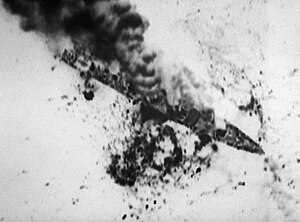Operation Praying Mantis
| Operation Praying Mantis | |||||||
|---|---|---|---|---|---|---|---|
| Part of the Iran–Iraq War | |||||||
 The Iranian frigate Sahand attacked by aircraft of U.S. Navy Carrier Air Wing 11 after the guided missile frigate USS Samuel B. Roberts struck an Iranian mine |
|||||||
|
|||||||
| Belligerents | |||||||
|
|
|
||||||
| Strength | |||||||
| 1 aircraft carrier, 1 amphibious transport dock 4 destroyers 1 guided missile cruiser 3 frigates |
2 frigates 1 gunboat 6 Boghammar speedboats (estimated) 2 F-4 fighters 2 platforms |
||||||
| Casualties and losses | |||||||
| 1 helicopter crashed (2 killed) | 1 frigate sunk (45 crew killed) 1 gunboat sunk (11 crew killed) 3 speedboats sunk 1 frigate damaged 2 platforms destroyed 1 fighter damaged |
||||||
| Cited by United States Naval Academy Prof. Craig L. Symonds as being decisive in establishing U.S. naval superiority. | |||||||
Operation Praying Mantis was an attack on 18 April 1988, by U.S. forces within Iranian territorial waters in retaliation for the Iranian mining of the Persian Gulf during the Iran–Iraq war and the subsequent damage to an American warship.
On 14 April, the guided missile frigate USS Samuel B. Roberts struck a mine while deployed in the Persian Gulf as part of Operation Earnest Will, the 1987–88 convoy missions in which U.S. warships escorted reflagged Kuwaiti oil tankers to protect them from Iranian attacks. The explosion blew a 4.5 m (15-foot) hole in Samuel B. Roberts's hull and nearly sank it. The crew saved their ship with no loss of life, and Samuel B. Roberts was towed to Dubai on 16 April. After the mining, U.S. Navy divers recovered other mines in the area. When the serial numbers were found to match those of mines seized along with the Iran Ajr the previous September, U.S. military officials planned a retaliatory operation against Iranian targets in the Persian Gulf.
According to Bradley Peniston, the attack by the U.S. helped pressure Iran to agree to a ceasefire with Iraq later that summer, ending the eight-year conflict between the Persian Gulf neighbors.
On 6 November 2003, the International Court of Justice ruled that "the actions of the United States of America against Iranian oil platforms on 19 October 1987 (Operation Nimble Archer) and 18 April 1988 (Operation Praying Mantis) cannot be justified as measures necessary to protect the essential security interests of the United States of America." However, the International Court of Justice dismissed Iran's claim that the attack by United States Navy was a breach of the 1955 Treaty of Amity between the two countries as it only pertained to vessels, not platforms.
This battle was the largest of the five major U.S. surface engagements since the Second World War, which also include the Battle of Chumonchin Chan during the Korean War, the Gulf of Tonkin incident and the Battle of Dong Hoi during the Vietnam War, and the Action in the Gulf of Sidra in 1986. It also marked the U.S. Navy's first exchange of anti-ship missiles with opposing ships and the only occasion since World War II on which the US Navy sank a major surface combatant.
...
Wikipedia
